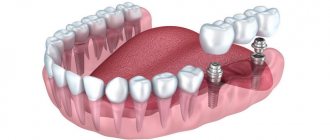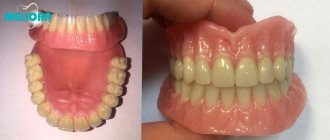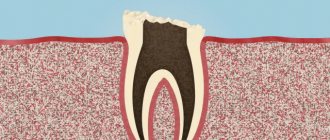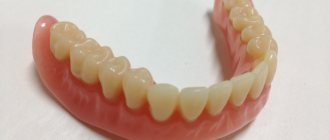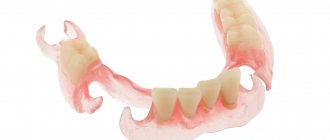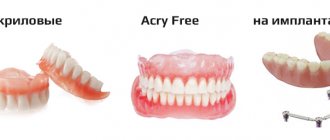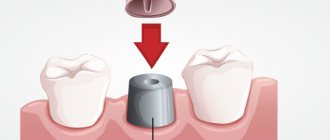Dental implants or bridges are used to restore lost teeth. Both options are functional and aesthetic. However, there are significant differences between them. To fix the bridge, the units adjacent to the defect are depulped and ground down. Due to improper load distribution, they gradually collapse and the jawbone atrophies. For an implant, these problems are eliminated. It is implanted into the jaw without the use of healthy teeth and prevents bone loss. When choosing a method, the patient should focus not only on finances, but also on long-term results.
In the photo - a dental bridge (left) and an implant (right)
What are bridges and dental implants?
A bridge is a permanent dental prosthesis consisting of crowns welded together, the outermost of which are fixed on previously ground living teeth. Used to restore 1-4 missing units in a row. The number of support units is always two. Bridges are usually created from the following materials: metal ceramics, zirconium dioxide. We install only metal-free structures.
Dental implants are artificial analogs of tooth roots that act as supports for individual crowns or dentures. Manufactured from medical titanium, biocompatible with oral tissues. Indicated for single, partial and complete edentia. They are implanted into the jaw using the following methods: classic, express, simultaneously with tooth extraction. They fully restore the functions and aesthetics of the dentition.
Dental prosthetic options
The main factors that determine the choice of dental prosthetics (if we do not take into account the financial factor for now) are the purpose of the procedure (esthetics or chewing function), as well as the number and location of teeth to be restored. To improve the appearance of healthy (usually front) teeth that have external defects (darkening, chips, cracks, misalignment or size), veneers (special ceramic onlays) or crowns are used.
Crowns are also used to preserve weakened or noticeably damaged (for example, broken or worn down) teeth. They are a kind of caps that are put on a ground tooth. They are made of metal (this outdated technology is still used in some clinics) or modern materials: plastic (temporary crowns), metal-ceramics and ceramics (porcelain, zirconium dioxide, etc.). Both veneers and crowns are non-removable prostheses.
In the absence of 1-2 teeth, either a bridge prosthesis is used - a metal structure (bridge) is attached to the adjacent teeth, used as a support, onto which crowns are fixed, completely reproducing the appearance and function of the lost teeth. Or it will be a prosthesis (crown or bridge) supported by implants.
The advantages of prosthetics on implants are the absence of the need to grind down adjacent teeth, the absence of additional load on them, and the transfer of chewing load to the jawbone (through the metal root), which prevents its atrophy.
The disadvantage is the rather high cost and the need to undergo surgery (implantation of an artificial metal root). If several teeth are missing in a row and it is impossible (or unwilling) to perform implantation, a removable denture is made. For example, clasp (design on a durable metal plate).
In case of complete absence of teeth (edentia), a prosthesis made of acrylic plastic is made. A distinctive feature of removable dentures (both clasp and acrylic) is the ability for the patient to remove and install them independently. The structure is fixed in the oral cavity with special clasps or micro-locks (for clasp ones), or by suction to the gum (for acrylic ones).
Fixed bridge
Restoring teeth with the installation of dentures that the patient cannot remove on their own is called permanent dental prosthetics. These include veneers, crowns (metal-ceramic or ceramic), dental inlays and bridges. Prosthetics on implants is also classified as a non-removable type.
But in some cases, prostheses are placed on implants, which are called conditionally removable. This is due to the fact that you cannot remove them yourself, but a dentist can easily dismantle them by unscrewing the fastening screws - for example, for professional cleaning, repair or replacement. The implants themselves will remain in place.
Crowns
Long gone are the days when crowns were made only of steel and gold. Today, many modern materials are used for dental prosthetics, which are not inferior in strength or aesthetics to natural teeth. The choice of a specific crown material is dictated by both the method of procedure and the financial capabilities of the patient.
Let's look at the advantages and disadvantages of the main types of dental crowns for prosthetics:
- metal ceramics – lining a metal frame with a ceramic composition,
- ceramics – made from porcelain, zirconium dioxide or glass ceramics.
Metal crowns can (and are sometimes) used today. They have undoubted advantages: high strength, teeth need to be ground less for them. But it is necessary to choose solid crowns made of high-quality metal and use them only for the farthest chewing teeth, where they will not be visible.
Ceramic crowns made from porcelain are cheaper, but are the least durable; glass ceramics are the most durable and beautiful, but the most expensive. Zirconium dioxide is the golden mean. Ceramic crowns are not used for prosthetics of chewing teeth due to their insufficient strength for this function. Their area of application is the front teeth, where aesthetics are very important and the chewing function is secondary.
Metal ceramics
Metal-ceramic crowns are excellent for restoring chewing teeth. They can also be used for prosthetics of front teeth, but in this case it is necessary to check their compatibility with existing natural teeth.
Metal-ceramic crowns are opaque (otherwise the metal base will show through the coating), so if your front teeth have a high coefficient of transparency, then teeth with crowns will differ from natural ones. If, nevertheless, a decision is made to prosthetize the front teeth with metal-ceramics, then it is better to choose crowns with shoulder mass, since they do not cause cyanosis of the gums, unlike conventional ones.
Complete dental prosthetics
In case of complete absence of teeth, it is necessary to make a removable or fixed denture. The removable option involves making an artificial jaw from polymer materials (acrylic, nylon, etc.). The structure is fixed in the oral cavity by suction to the gums, just like a suction cup is attached to glass.
The production of such a prosthesis is quite fast, their prices are moderate, and installation does not involve any serious interventions. However, they also have serious disadvantages. The prosthesis must fit perfectly. If it does not fit perfectly, or if during use the shape of the soft tissues has changed slightly (and it will change, because the design does not transfer the chewing load to the jaw bone, which is why bone atrophy will continue), then the prosthesis will not hold well and keep falling out.
The removable version is very massive, extends far beyond the dentition, rests on soft tissue and in some patients causes a gag reflex. Getting used to such a design is a very slow matter (up to 1 month), and some people do not manage to get used to it at all. Hard dentures often rub the gums during chewing, while soft dentures distribute the load unevenly, causing discomfort. The service life of removable polymer dentures is 5-7 years in the most favorable case.
An alternative is complete dental prosthetics using fixed (or conditionally removable) structures supported by implants. The most commonly used are 3 methods: basal implantation, prosthetics on 4 implants (All-on-4) or prosthetics on 6 implants (All-on-6). Basal implantation means the placement of 8-12 elongated implants into the dense layers of the jaw bone.
The advantage of this method is the absence of the need to do bone augmentation, the ability to do without cutting the gums and drilling the bone, the initial strong fastening of the implants, which allows you to immediately install a prosthesis on them. On the other hand, placing a large number of implants makes the procedure more complex, and the lack of large-scale studies of the behavior of implants over many years does not allow for firm guarantees, unlike other implantation methods, which provide a lifetime guarantee on the implants.
Prosthetics on 4 implants
More predictable and well-researched is the method of dental prosthetics on 4 implants. It also allows you to receive a ready-made fixed prosthesis within 3 days after surgery. But the peculiarity of this type is that this design will be temporary and will have to be replaced with a permanent one in a few months (from 5 to 24 months, depending on individual characteristics).
The main difference between the different types of temporary structures is the presence of a metal frame. A temporary prosthesis with a frame is optimal - it is strong enough to last 2-3 years before being replaced with a permanent one. But embedding a metal frame with a screw connection with implants into an acrylic base is a very labor-intensive procedure, due to which the cost will be noticeably more expensive.
An acrylic temporary denture without a metal frame will be cheaper, but it has noticeably less strength, which is why its service life does not exceed 5 months, and even during this time, structural failures are common, especially in men with large and well-developed jaws. A temporary (adaptation) prosthesis must be properly maintained - once every six months (and sometimes more often) it requires professional cleaning by a dentist, and once a year - replacement of the fixing screws.
There are many types of permanent structures for all-on-four prosthetics, so the desired option is selected individually in each clinic, according not only to the specific clinical situation (for example, the amount of space for dentures, determined by the degree of atrophy of the jaw bone), but also to the capabilities of the clinic and the patient.
The highest quality are titanium-polymer prostheses from Nobel Biocare, however, they are characterized by high cost and require a large amount of space for prosthetics, i.e. Patients with a slight degree of bone atrophy will not be able to install them.
Another option is bridge-like structures made of zirconium dioxide or metal ceramics. Their frame can be made of titanium or zirconium dioxide, and in some cases of nickel-chromium alloy, but the beam must be milled. The use of cast structures reduces the strength and accuracy of fit, which can lead to problems in the future.
Prosthetics on 6 implants
The previous method is not suitable for all patients. In large men, young men (under 55 years of age), those who prefer solid foods (meat, fresh vegetables), and those with very soft bones, implants located on the side will experience increased stress, which will inevitably lead to their loosening, resorption of bone tissue around the implants and breakage (or loss) of the prosthesis after a few years.
For such patients, dentures with 6 implants are always recommended as a more reliable and suitable option to avoid overloading the lateral implants. The operation can also be performed using surgical guides or the traditional method with incisions. Loading of installed implants with a prosthesis can be performed within 2-3 days after surgery.
To install a prosthesis, it is better to use branded Multi-unit abutments, since to remove the prosthesis in the future (if it is necessary to clean or replace a temporary one with a permanent one), Multi-unit abutments, unlike standard ones, allow you to remove only the prosthesis, and other abutments will have to be removed along with it , injuring the gums, which creates a risk of infection and the development of inflammation of the tissue around the implants, and this, in turn, can lead to rejection.
A temporary (adaptive) prosthesis is usually included in the cost of prosthetics using the “all on 6” system, just like the “all on 4” system. And the permanent one will have to pay extra. Temporary, as already discussed above, it is better to choose one with a metal frame, especially for men, even though it will be more expensive. It is better to choose a permanent one based on milled titanium or zirconium beams, or, in extreme cases, cobalt-chrome beams. Cast beams are significantly less strong and their fit is less precise.
It should be noted that prosthetics using the “all on 4” and “all on 6” systems always imply implantation with immediate loading, i.e. the prosthesis (temporary) is placed immediately - within 3 days after the operation. Some clinics offer installation using a delayed loading protocol - i.e. after 4-6 months, during which you will have to use a conventional removable acrylic denture. But this is not an “all on 6” (or “all on 4”) technique, but a conventional two-stage implantation.
Partial prosthetics
In the absence of part of the dentition, partial dental prosthetics is performed using a bridge or clasp prosthesis. Those. In this case, structures can be removable or non-removable. To install a fixed bridge, healthy abutment teeth must be preserved at the edges of the edentulous area. The bridge is a metal arch on which crowns are located, simulating missing teeth.
Along the edges there is a system of attachment to the supporting teeth. They are ground down and crowns are also put on them. In the absence of supporting ones, it is possible to install a bridge prosthesis on implants. A removable bridge with partial absence of teeth also implies that the structure will be attached to the supporting teeth. These can be dentures made of acrylic or nylon, or clasp ones.
Partial plastic dentures have clasps with which they are attached to the supporting teeth. Because of this, this type of denture is not used in cases where the supporting ones are located in the smile area, because the clasps will be visible. In addition, such dentures can cause discomfort and pain when chewing. It will be more convenient to install clasp frames.
Clasp prosthetics
A characteristic design feature of clasp dentures is a special metal arch (clasp). In the upper jaw structure it passes through the palate, and in the lower jaw it passes behind the front teeth, adjacent to the alveolar ridge of the jaw bone. The metal base is made of titanium, cobalt-chrome alloy, or precious metals.
Its strength makes it possible to reduce the total weight of the structure and the thickness of the plastic base, which has a positive effect on the ease of use of the prosthesis. For clasp dentures, the supporting teeth located on both sides of the jaw must be preserved.
This is one of the most optimal options for a removable bridge, because:
- clasp dentures effectively restore chewing function,
- firmly fixed on the jaw,
- do not impair diction,
- have a long service life.
To fix the clasp structure, various mechanisms are used - clasps (wire loops), micro-locks and telescopic crowns. The best, most reliable and aesthetically impeccable are clasp dentures with micro-locks and especially telescopic crowns.
They have one drawback - they are very difficult to manufacture and require highly qualified orthopedists and dental technicians, and therefore have a higher cost. But they better transfer the chewing load to the supporting teeth and practically do not cause their destruction, which, for example, occurs with the clasp system on clasps.
Prosthetics of lower teeth
The procedure has a number of features. First of all, aesthetic requirements for the lower teeth are less stringent, since the lower teeth are not as visible as the upper teeth. Also, the lower teeth are subject to a much greater chewing load, which places greater demands on the strength of the prosthesis and the reliability of its fixation.
And in addition, the anatomical features of the lower jaw (absence of a hard palate, frenulum of the tongue, etc.) make dentures difficult, making the task of achieving a strong fixation of the prosthesis much more difficult. As a result, prosthetics for the lower teeth turns out to be somewhat more complex, and the dentures may have a slightly different design. However, the same technologies apply to the lower teeth.
To restore healthy teeth with partial external damage, veneers and crowns are used here, and if 1-4 teeth are completely lost, a permanent bridge can be installed, supported by ground adjacent teeth. Or a removable plate made of acrylic or nylon, with clasps made of metal wire or polymer material.
If there are supporting teeth on both sides of the jaw, it is possible to install a clasp prosthesis, the design of which will differ from that used for prosthetics of the upper teeth in the shape and location of the arch. In case of complete edentia (absence of teeth) in the lower jaw, the dentition is restored using a removable full plate bridge, or a conditionally removable one on implants.
The latter option has a secure fit and impeccable functionality. In the lower jaw, implantation is easier, and the higher bone density often makes it possible to avoid lengthy and expensive bone augmentation surgery. Implants completely imitate natural teeth, including transferring the chewing load to the jawbone, which slows down its atrophy and allows you to use the prosthesis without correction or replacement for a longer time.
Prosthetics of anterior teeth
Front teeth always play an important role in a person’s appearance, so their restoration is almost always an urgent and pressing task that is important to solve as quickly as possible. As a result, prosthetics of the front teeth is associated not only with recreating the shape and appearance of the tooth itself, but also with the aesthetics of a smooth and beautiful gingival margin.
You can correct aesthetics (darkening, abrasion and small chips, gaps between teeth) with the help of veneers or lumineers, and you can restore severely damaged teeth by installing crowns on them. When one or more front teeth are lost, the problem of prosthetics is best and most effectively solved by installing implants.
The chewing load on them in this area is minimal, and quick prosthetics after tooth loss eliminates bone resorption and makes bone grafting unnecessary. When implanting with immediate loading, the patient receives a fully functional structure immediately (however, several months later, after the implant has completely engrafted, the prosthesis will have to be replaced with a permanent one).
In the case of a two-stage implantation protocol, while the implant is healing, the hole is closed with a temporary butterfly prosthesis, fixed with polymer clasps to the adjacent teeth. And after a few months, a gum former is placed, and after another 3-4 weeks - a permanent option. If implantation is not possible, one of the best options would be to install a clasp prosthesis.
Urgent prosthetics
If it is necessary to restore the integrity of the dentition as soon as possible, the patient is offered emergency dental prosthetics, which usually involves installation within one day. These can be temporary removable structures made of acrylic or nylon, other types of plastic, or non-removable ones - for example, temporary crowns. This type of dental prosthetics is used during tooth extraction and during the restoration process.
Another option is express implantation. Installation of a special implant with a bioactive surface can be non-surgical, or rather performed without an incision in the gum. A temporary crown or prosthesis can be immediately installed on such implants.
A characteristic feature of urgent prosthetics is that it is always a temporary structure that must be replaced with a permanent one after some time. Such prostheses are not very durable and have a limited service life.
Turnkey prosthetics
When calculating the cost of dental prosthetics, it is important to take into account all the nuances and costs at all stages. Clinics often try to show a lower cost of the procedure, without including in the price list the cost of some materials or procedures, which the patient will nevertheless have to pay.
That is why such an item as turnkey prosthetics arose. This means that by paying the specified amount, the patient will receive a fully functional prosthesis and will not have to pay anything else for this. However, it is necessary to take into account that in some cases the turnkey cost includes only the cost of manufacturing and installing a temporary prosthesis, which will later have to be replaced with a permanent one.
The cost of a permanent structure and its installation is not included in the price of the turnkey procedure, primarily because the permanent structure is installed several months (6 or more), or even 2-3 years after temporary dental prosthetics. And it is simply impossible to calculate in advance the cost of permanent dentures for months and years in advance, without knowing what type of prosthesis will be installed and how prices will change.
Pros of the methods
If we compare both options, then both the bridge and the implant are non-removable structures, matched to the color and shape of the patient’s natural teeth, and restore the functionality of the dentition. However, each method has individual advantages.
Pros of bridges on your teeth:
- shortened treatment periods;
- minimum contraindications;
- affordable price.
Advantages of implants:
- functional, aesthetic;
- allow you to restore any number of lost units;
- suitable for restoring terminal defects of the dentition;
- prosthetics with single crowns, bridges and complete dentures;
- have increased stability;
- distribute the load evenly, protect the jaw bone from resorption;
- crown replacement is performed without removing the titanium root;
- have a lifetime service life (for Nobel Biocare models).
The main advantage of implants compared to classic bridges is that to install the prosthesis, it is not necessary to grind down the units adjacent to the defect.
Contraindications
Among the limitations to classical bridge prosthetics:
- diseases of periodontal tissues (periodontal disease, periodontitis);
- serious malocclusion;
- pathological abrasion of enamel;
- inflammation of the oral cavity;
- osteoporosis and other diseases of the jaw bone tissue.
Dental implants are contraindicated in the following cases:
- high blood pressure;
- blood diseases;
- malignant neoplasms;
- diseases of the cardiovascular, endocrine, nervous systems;
- uncompensated diabetes mellitus;
- mental disorders;
- HIV AIDS;
- tuberculosis;
- infectious processes in the body;
- gum disease;
- age up to 16 years.
Implantation is also not performed in case of relative contraindications - lactation and pregnancy in women, if the patient has bad habits (smoking, alcohol abuse, drug use).
Restrictions on installing an artificial root
Implantation is indicated when a person is missing one or more teeth and there is significant destruction of the nearest ones. Dentists also advise installing artificial roots in cases where the patient is categorically against grinding down adjacent teeth. It is recommended to install an implant in cases where it is not possible to install a bridge.
Crowns should be placed in situations where:
- There is no protective layer of the tooth;
- Increased abrasion is observed;
- Most of the tooth is damaged by caries.
A crown differs from an implant in that the latter can be used to restore a lost tooth, while the former helps preserve a damaged one. The doctor chooses what is the best option in each specific case.
There are a number of absolute contraindications for installing an artificial root:
- Various neoplasms;
- Diabetes mellitus in a severe stage of development;
- Tuberculosis;
- Disturbances in the functioning of the nervous system;
- Various mental disorders;
- Blood diseases;
- Inflammatory diseases of an infectious nature, localized in the area of the mucous membranes of the mouth;
- Weakening of the immune system;
- Exacerbations of various chronic diseases.
When placing an implant, the doctor must take into account the condition of the hard tissues of the jaw and their integrity. If the last point is violated, an artificial root cannot be installed.
There are also a number of relative contraindications for implantation of a metal pin:
- Pregnancy, breastfeeding;
- Insufficient compliance with hygiene measures;
- Bite disorders, congenital jaw defects;
- Inflammatory processes in the gums;
- Excessive smoking, alcohol abuse.
When deciding to install a titanium root, you should take into account all these contraindications and consult with an experienced specialist. Only after all possible risks have been eliminated is prosthetics using a pin possible.
Possible complications
After installing the bridge, the patient may encounter the following problems:
- sensation of a foreign body in the mouth in the first 5-7 days;
- pain (if you have this symptom, we recommend that you consult a doctor);
- food getting under the prosthesis (in case of improper fixation of the structure);
- peeling off crowns (occurs with bruxism in a patient);
- exposure of the neck of the supporting unit.
Complications after implantation occur in less than 5% of clinical cases. Among them:
- bleeding (occurs when a patient has a blood clotting disorder);
- pain (in the first 5-7 days this is a normal reaction to surgery, after this period it is a reason to consult a doctor);
- seam divergence;
- perforation of the bottom of the maxillary sinus;
- damage to the mandibular nerve (accompanied by numbness);
- peri-implantitis (inflammation of the gum tissue around the implant);
- design rejection.
Implants are a profitable solution
Classic bridge prosthetics is less expensive than implantation. However, if you take into account the costs of depulping the supporting units before installing a bridge and the need to replace the prosthesis every 7 years (in the best case scenario), implants are a profitable solution. Titanium roots do not destroy healthy teeth and have a lifetime service life, and zirconium dioxide crowns will not require replacement for at least 20 years.
Levin Dmitry Valerievich
Chief physician, Ph.D.
What is better to put on the front teeth?
Implantation is the best option when restoring anterior units. This is due to increased demands on aesthetics. The bridge initially corresponds to them, but gradually, due to atrophy of the jaw bone, it sags, becomes mobile, and a gap appears between it and the gum. The implant, on the contrary, preserves the healthy appearance of the gums and compacts the surrounding bone tissue. As part of the classical installation method, the formation of the correct gingival contour is additionally carried out. Aesthetics do not deteriorate throughout the entire service life of the structure.
Indications for installation of bridges
Let's look at situations where it may be recommended to replace missing teeth with bridges. Such indications may include:
- absence of teeth (one or more);
- financial difficulties that do not allow the patient to use dental implants;
- chronic diseases or conditions in which implantation is contraindicated (dystrophy of the jaw bone, pathology of the oral mucosa, general chronic diseases, etc.).
The main advantage of replacing missing teeth with bridges is that they are cheap and accessible to people of low income. However, due to a host of shortcomings, bridges are gradually giving way to more advanced types of prosthetics.
What to choose for a chewing tooth
In this case, the bridge and the implant have their own advantages and disadvantages. A bridge allows you to quickly restore the functionality of the dentition and cope with the chewing load normally. However, uneven distribution of pressure gradually leads to destruction and removal of supporting teeth.
The implant does not have a destructive effect on neighboring units; in all respects it is identical to a natural tooth. However, when installing a titanium root in the masticatory region, loading with a full-fledged prosthesis is not allowed until the artificial root has completely engrafted.
Pros and cons of implantation
The ideal orthodontic design is created taking into account high aesthetic parameters, especially for the front teeth. And first of all, its functionality must be taken into account. So, an artificial rod with a crown is precisely the only system that meets these requirements. It is tightly fixed in the bone, which prevents atrophy of hard tissues, withstands good chewing load, does not negatively affect the aesthetic properties of the gums, and looks like a natural tooth.
With careful care, a titanium rod will serve patients for a lifetime. And the crown, unfortunately, has to be changed after ten to fifteen years. The bone tissue is loaded evenly and correctly, which prevents loss of its volume, which bridges cannot do. It is worth considering that the absence of a unit for a long time causes displacement of neighboring organs. And then, when installing the rod, it will be necessary to build up the bone and turn the bent unit. This situation is fraught with changes in the oval of the face and bite, drooping of the corners of the lips, the appearance of nasolabial folds, not to mention problems with chewing food. Therefore, to avoid all this, consult a doctor on time!
The ideal aesthetic effect is achieved by working not only with hard tissues, but also with gingival tissues. Removal of the units is usually combined with the placement of an artificial rod. This preserves the shape and color of the soft tissues. More detailed information can be found at the link Single-stage dental implantation. In this case, the patient should not have inflammation, but there should be sufficient bone volume. In such a situation, neighboring healthy teeth will not be harmed in any way. Another advantage is that it is possible to restore not only single teeth, but also the jaw with general edentia. Only a few rods are implanted, and that is enough.
As for the shortcomings, there are practically none. True, there are contraindications. The ban applies to patients with severe cardiovascular diseases, serious diseases of the blood, liver, and connective tissue. The procedure is not prescribed for clients with thyroid pathology, mental disorders, allergies to antiseptics and antibiotics. Implantation is not performed if you are taking bisphosphonates systematically, which affect bone structure. But there is good news: in modern dentistry, the list of prohibitions depends on the installation technology.
Clinical cases
- If one tooth is missing . When restoring a single defect, the condition of neighboring units is taken into account. If they are healthy, it is better to choose implantation, since bridge prosthetics involves depulping the supporting teeth. If they are already pulpless, you can install a bridge.
- If several teeth are missing in a row . The choice of method depends on the extent of the defect. A bridge can restore no more than four missing teeth in a row. Implants - any quantity. In this case, it is not necessary to place a separate rod in place of each lost unit. There are options to fix a smaller number of titanium supports and cover them with a bridge. A bridge on implants does not destroy healthy teeth, the load is distributed evenly, and jawbone loss is eliminated. Plus treatment is cheaper.
- End defect . If the outermost teeth in a row are lost, the only option is implantation, since to fix the bridge at the edges of the defect there must be two supports.
Aesthetic result
When consulting a patient on what is better: a dental bridge or implants, the dentist also touches on the issue of aesthetics of the structures. At an early stage after treatment, the cosmetic results of recovery are equally high. Therefore, the difference between a crown on an implant and a bridge on supporting teeth is invisible to a non-specialist. However, over time, the bone tissue under the bridge structure can atrophy, as a result of which the gums sag and the aesthetic effect of prosthetics is greatly reduced. This does not happen with implantation.
What is better - dental implantation or bridge?
For a clear example of the strengths and weaknesses of both options, we provide a comparative table.
| Bridge | Implant | |
| Number of missing teeth | 1-4 | any quantity |
| Degree of mastication recovery | average | full identity to a natural tooth root |
| Aesthetics | average | high |
| Recovery time | up to 1 month | 4-6 months, with bone grafting - up to 1 year |
| Difficulty of installation | average | complex |
| Impact on adjacent teeth | subject to depulping and turning | are not used |
| Jaw bone loss | intense | absent |
| Reliability of fixation | mobility of supports is possible in case of diseases and inflammation of periodontal tissues | complete immobility |
| Difficulty of care | Difficulties arise when food gets under the prosthesis | does not require special care |
| Restrictions on food intake | increased load excluded | any load is allowed |
| Comfort while wearing | There is discomfort in the first days after installation | complete comfort |
| Life time | up to 7 years, depending on the condition of the support units | implant - for life, prosthesis - 15 years or more |
| Price | Average | High |
Our dentists recommend that patients do not delay the restoration of missing teeth. Without load, the jawbone begins to atrophy. The method of filling a gap in the dentition must be decided quickly. Each patient, taking into account his financial capabilities, makes his own decision - whether it will be a bridge or an implant.
What is an implant
An implant is a prefabricated structure for prosthetics, consisting of several elements:
- artificial root - made of durable titanium alloy;
- abutment - the junction of the root and crown;
- a crown that is fixed to a pin.
Installation of modern dental implants is a common method of restoring the integrity of the dentition. The process consists of a set of procedures, including:
- building up bone tissue to the required volume, if it is not enough;
- implantation of an artificial root and its engraftment;
- fixation of artificial crowns.
Implantation will require patience from the patient. It is important to note that the result is worth it - artificial teeth will fit perfectly into the dentition and will perform all the functions of natural teeth.
As a rule, implantation is used when there is no desire to install removable orthopedic structures. Many patients want to do without grinding healthy teeth.
We most often recommend to our patients the installation of an implant to replace each lost tooth. An artificial tooth does not have natural mobility, so when installing a fixed structure, the patient may experience discomfort.
Ask a Question

